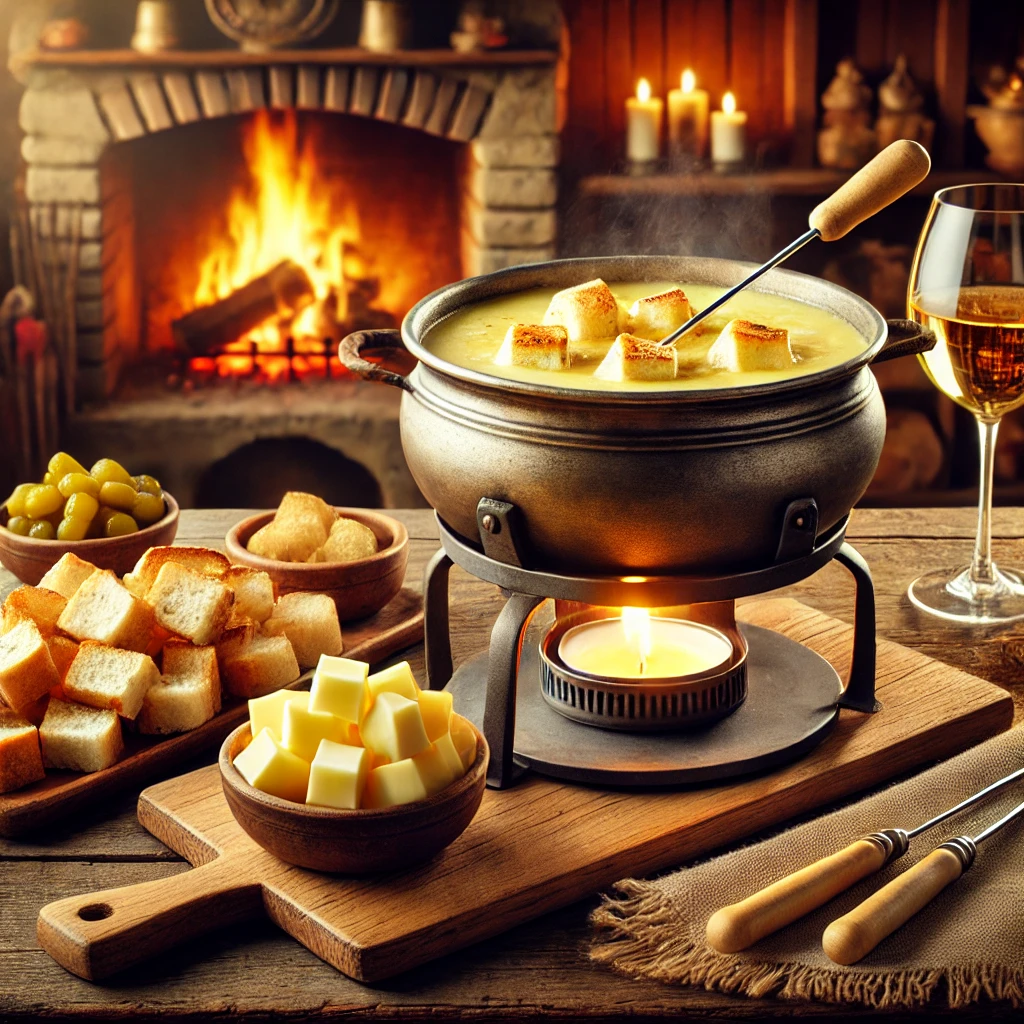When one thinks of Swiss cuisine, the image of a bubbling pot of cheese fondue likely comes to mind. This iconic dish, with its roots in the alpine regions of Switzerland, is more than just a meal—it’s a communal experience that brings people together around a shared pot of melted cheese. Classic Swiss fondue, with its rich history, simple ingredients, and enduring appeal, remains a favorite for both Swiss natives and food enthusiasts around the world. In this blog post, we’ll explore the origins, key components, preparation methods, and variations of classic Swiss fondue. Whether you’re hosting a winter gathering or simply craving comfort food, this guide will help you create an authentic and memorable fondue experience.
A Brief History of Swiss Fondue
The word “fondue” comes from the French verb “fondre,” meaning “to melt,” which perfectly describes this dish that revolves around melted cheese. Fondue’s history is as rich as the dish itself, with its origins tracing back to the Swiss Alps.
In the 18th century, Swiss peasants in the mountainous regions of Switzerland relied on simple, available ingredients during the harsh winters. Cheese, bread, and wine were staples, and the practice of melting cheese with wine to create a hearty dish was born out of necessity. The combination of aged cheese and wine, heated together to create a smooth, velvety mixture, provided sustenance and warmth. Stale bread, dipped into the hot cheese, became a satisfying meal that made use of every available resource.
By the 1930s, Swiss fondue had become a national dish, promoted by the Swiss Cheese Union as a way to increase cheese consumption during economic downturns. It quickly grew in popularity, and by the 1960s, fondue had gained international acclaim, especially in the United States, where it became synonymous with cozy winter gatherings.
Today, fondue is a symbol of Swiss hospitality and a beloved culinary tradition that transcends borders.
The Essential Components of Classic Swiss Fondue
Creating an authentic Swiss fondue requires just a few key ingredients, but the quality of these ingredients is paramount. Here’s what you’ll need:
1. The Cheese
Cheese is the star of the show in a classic Swiss fondue. Traditionally, a blend of two types of Swiss cheese is used: Gruyère and Emmental. Gruyère is known for its nutty, slightly sweet flavor, while Emmental adds a mild, buttery richness. The combination of these two cheeses creates a well-balanced, flavorful fondue.
For a more complex flavor, some recipes may also include Appenzeller or Raclette cheese. Whatever blend you choose, it’s important to use high-quality, aged cheese to achieve the best results.
2. The Wine
Wine plays a crucial role in fondue, both for flavor and texture. A dry white wine, such as a Swiss Fendant or a French Sauvignon Blanc, is typically used. The acidity of the wine helps to prevent the cheese from becoming stringy and ensures a smooth, creamy consistency.
In some variations, a splash of kirsch (a clear cherry brandy) is added for extra flavor and a touch of sweetness. However, this is optional and depends on personal preference.
3. The Starch
A small amount of starch, usually cornstarch or flour, is used to stabilize the fondue and prevent the cheese and wine from separating. The starch is often mixed with the wine before being added to the cheese, ensuring a smooth, cohesive mixture.
4. The Seasonings
Seasonings for classic Swiss fondue are simple but essential. Garlic is typically rubbed around the inside of the fondue pot before the cheese mixture is added, infusing the dish with subtle flavor. A pinch of nutmeg and a dash of white pepper are also common, enhancing the cheese’s natural flavors without overpowering them.
5. The Bread
No fondue is complete without bread for dipping. Traditionally, a crusty Swiss bread like pain de campagne is used. The bread should be cut into bite-sized cubes with a good ratio of crust to soft interior, ensuring it holds up when dipped into the hot cheese without becoming soggy.
Preparing the Perfect Classic Swiss Fondue
Making Swiss fondue is a straightforward process, but it requires attention to detail to achieve the perfect consistency and flavor. Here’s a step-by-step guide:
1. Prepare the Fondue Pot
Start by preparing your fondue pot, known as a caquelon. Rub the inside of the pot with a cut clove of garlic. This step is important, as it imparts a subtle garlic flavor without overwhelming the dish.
2. Heat the Wine
Place the caquelon on the stove over medium heat. Pour in the dry white wine and bring it to a gentle simmer. Do not let the wine boil, as this can affect the fondue’s texture.
3. Add the Cheese
Gradually add the grated cheese to the simmering wine, stirring constantly with a wooden spoon in a figure-eight motion. Adding the cheese slowly and stirring continuously helps to ensure that it melts evenly and combines smoothly with the wine.
4. Add the Starch
Mix the cornstarch with a small amount of wine or kirsch to create a slurry. Stir this mixture into the cheese and wine, continuing to stir until the fondue is smooth and creamy. The starch will help to thicken the fondue and prevent it from separating.
5. Season the Fondue
Once the cheese has melted completely and the fondue has reached a smooth consistency, season it with a pinch of nutmeg and white pepper. Taste and adjust the seasoning as needed.
6. Transfer to the Fondue Stand
Carefully transfer the caquelon to a fondue stand with a heat source underneath to keep the fondue warm. The heat should be low to maintain the fondue’s consistency without overheating it.
Enjoying Classic Swiss Fondue
Fondue is as much about the experience as it is about the food. Here’s how to make the most of your fondue meal:
1. Dipping Techniques
To enjoy your fondue, spear a cube of bread with a fondue fork and dip it into the cheese, making sure to coat it thoroughly. Twirl the bread slightly as you lift it out of the pot to prevent dripping.
2. The Social Aspect
Fondue is traditionally a communal dish, meant to be shared among friends and family. It’s a slow, leisurely meal that encourages conversation and camaraderie. Traditionally, if a piece of bread is lost in the pot, the person responsible may have to perform a playful forfeit, such as buying a round of drinks or singing a song.
3. Pairing with Drinks
A classic Swiss fondue pairs beautifully with white wine, especially the same variety used in the dish. A crisp, dry Swiss wine like Fendant or Chasselas is a popular choice. If you prefer something non-alcoholic, hot tea is traditionally served alongside fondue, as it’s believed to aid digestion.
Variations on Classic Swiss Fondue
While the classic cheese fondue is timeless, there are several variations that offer different flavors and ingredients. Here are a few popular options:
1. Fondue Moitié-Moitié
This variation is common in the Fribourg region of Switzerland and translates to “half and half.” It’s made with equal parts Gruyère and Vacherin Fribourgeois cheese, resulting in a slightly creamier and milder fondue.
2. Fondue Neuchâteloise
Originating from the Neuchâtel region, this version typically uses a blend of Gruyère and Emmental cheeses, with a splash of kirsch added for a more pronounced flavor.
3. Tomato Fondue
In this variation, tomato purée or fresh tomatoes are added to the cheese mixture, creating a fondue with a tangy, slightly acidic flavor that pairs wonderfully with bread and potatoes.
4. Mushroom Fondue
This version incorporates sautéed mushrooms into the cheese mixture, adding an earthy, umami flavor to the fondue. It’s a perfect choice for mushroom lovers looking for a unique twist on the classic dish.
Fondue Beyond Cheese: Dessert Fondue
While cheese fondue is the most traditional, the concept of fondue has expanded to include dessert versions as well. One of the most popular is chocolate fondue, where melted chocolate is served with an assortment of fruits, marshmallows, and other sweets for dipping. It’s a decadent and fun way to end a meal, making it a favorite at parties and gatherings.
Conclusion
Classic Swiss fondue is more than just a dish—it’s a tradition that embodies the warmth, hospitality, and simplicity of Swiss culture. Whether you’re enjoying a cozy winter evening at home or hosting a fondue party with friends, this dish offers a unique and interactive dining experience that’s sure to delight. With its rich history, simple ingredients, and endless variations, fondue remains a beloved culinary classic that continues to bring people together around the table. So gather your loved ones, light the fondue pot, and enjoy the timeless pleasure of dipping into a pot of warm, melted cheese.






